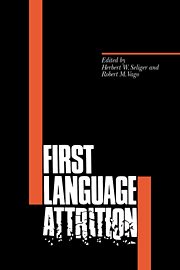Book contents
- Frontmatter
- Contents
- List of figures
- List of tables
- List of contributors
- Acknowledgment
- Part I Survey studies
- Part II Group studies
- 6 L1 loss in an L2 environment: Dutch immigrants in France
- 7 The sociolinguistic and patholinguistic attrition of Breton phonology, morphology, and morphonology
- 8 Language attrition in Boumaa Fijian and Dyirbal
- 9 Pennsylvania German: convergence and change as strategies of discourse
- 10 Lexical retrieval difficulties in adult language attrition
- 11 Spanish language attrition in a contact situation with English
- Part III Case studies
- Index
7 - The sociolinguistic and patholinguistic attrition of Breton phonology, morphology, and morphonology
Published online by Cambridge University Press: 14 January 2010
- Frontmatter
- Contents
- List of figures
- List of tables
- List of contributors
- Acknowledgment
- Part I Survey studies
- Part II Group studies
- 6 L1 loss in an L2 environment: Dutch immigrants in France
- 7 The sociolinguistic and patholinguistic attrition of Breton phonology, morphology, and morphonology
- 8 Language attrition in Boumaa Fijian and Dyirbal
- 9 Pennsylvania German: convergence and change as strategies of discourse
- 10 Lexical retrieval difficulties in adult language attrition
- 11 Spanish language attrition in a contact situation with English
- Part III Case studies
- Index
Summary
Introduction
This contribution is based on empirical field research in two areas of Celtic Lower Britanny in western France:
in the local Trégorrois (Trég.) dialect of Buhulien south-east of Lannion (western fringe of the Département Côtes du Nord), cf. Dressler (1972a, b),
in the South Bigouden (Big.) subdialect of the Cornouaillais dialect, south-west of Quimper (southwesternmost part of the Département Finistère), cf. Dressler & Hufgard (1980).
Similar to Dorian (1981), I distinguish six groups of speakers according to qualitative and quantitative criteria of their competence in Breton (birth dates are only approximative):
(I) Healthy Breton speakers corresponding to Dorian's “older fluent speakers,” born between 1892 and 1932 (with clusters around 1896-1900 and 1912-1920). My descriptions of dialects (Dressler 1972a; Dressler & Hufgard 1980) are based on these speakers.
(II) Weaker Breton speakers, approximately corresponding to Dorian's “younger fluent speakers,” born between 1911 and 1942. The only reduction they show are consequences of a certain shrinkage of their Breton lexicon.
(III) Preterminal speakers, born between 1938 and 1951, show reductions and generalizations also in grammar.
(IV) Better terminal speakers, born between 1936 and 1952, exhibit even more reductions and generalizations.
(V) Worse terminal speakers, born between 1933 and 1962, have a severely reduced lexicon and a still more reduced grammar.
(VI) Rememberers recall only isolated items (they are not considered in the present study).
In Sections 2–4 I am going to deal with sociolinguistic attrition in the phonology, morphology, and morphonology of the two dialects of Breton mentioned above – not with literary Breton, which has experienced a certain renaissance since the early 1970s – and in Section 5 with patholinguistic, i.e. aphasic, attrition.
- Type
- Chapter
- Information
- First Language Attrition , pp. 99 - 112Publisher: Cambridge University PressPrint publication year: 1991
- 24
- Cited by



